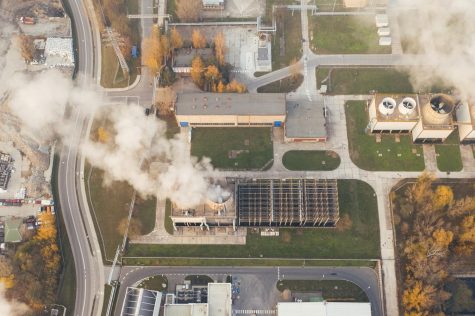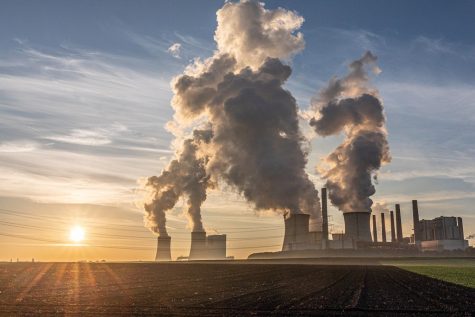Climate Change Guest Column: A Most Uncertain Fiction
Edward Roberts, under the anonym “strannikov”, has written flash fiction since 2007 appearing online at Delicious Demon, Language Is a Virus, Gone Lawn Journal, Metazen, Dead Mule School of Southern Literature, Fictionaut, and The Miscreant. His verse (since 2016) has appeared at Fictionaut and Literati Magazine and in print at Chiron Review.
While the melting of West Antarctica’s Pine Island Glacier and Thwaites Glacier is likely due to a misfortunate combination of geothermal activity beneath the Antarctic ice sheet with atmospheric and oceanic effects courtesy of Technogenic Climate Change (hereafter, TCC), the fact remains that both glaciers are exhibiting historically high rates of melt, measured by losses of glacial mass in the gigatonnes (one gigatonne equals one billion metric tons).
The melting of these glaciers shows no sign of abating. As their melting continues across Antarctic summers, concerns rise particularly over the status of the Thwaites Glacier (dubbed “the Doomsday Glacier” by media sages), since the volume of its melting ice alone has been calculated to be able to contribute a full two feet to global sea level rise once it has dissolved into the planet’s oceans.
Just as the cause of this melting is likely a combination of geothermal action with the atmospheric and thermal oceanic expansion effects of TCC, there is every expectation that the loss of ice mass will continue. It is almost equally likely that as the rate of melt continues, the rate of melt will continue to accelerate. And just as the melting of these immense glaciers will likely proceed apace over the coming century, it is as likely that their melting into the world’s oceans cannot be stopped now no matter what action anyone takes and that significant mean sea level rise globally by the end of 2121 is already inevitable.
And because or although it is likely already too late to forestall these events, humanity will accomplish nothing or next to nothing over the coming decade to counter the pernicious atmospheric and oceanic effects of TCC. (If institutional and bureaucratic responses to the urgencies of a global pandemic have been hotly contested, just how deftly can anyone expect institutional and bureaucratic responses to the onset of TCC to be as we sail past goals and targets already unmet for new goals and targets that have perhaps no better chance of implementation?) Assuming for a few moments that this is so, perhaps by the end of the next decade humanity will be able to see finally not only that TCC poses actual threats but that by 2031 the phenomenon will have to be properly named Runaway Technogenic Climate Change, meaning that many of the processes unleashed, as they accelerate and aggravate natural climatic, meteorological, and oceanic dynamics, will begin wreaking significant havoc upon the humanity that has been unleashing their lethal contributions across recent centuries.
The scale of human dislocations we might anticipate in theory cannot yet be precisely calculated, but the displacement of tens of millions of people (one hundred million would be a bare global minimum) and the loss of the cities, ports, and coastal regions they will be forced to evacuate will occur even if precise calculations cannot be performed for another two or three decades. In the interim it’s anyone’s guess about what continuing ice sheet melting in Greenland and Antarctica might yield. It’s anyone’s guess what the cumulative loss of the world’s mountain glaciers will entail, from the Rockies to the Alps, from the Andes to the Himalayas. It’s anyone’s guess about how the global climate will respond “naturally” with flooding in some locales and droughts in others, both of which will affect agricultural yields for humans and livestock.
Nobody knows anything about the foregoing with any certainty, for the simple reason that the data are not yet available and their analysis remains uncertain. Yet if the foregoing catalogue of coming attractions holds any merit and if at least some of these phenomena begin to occur over the next century (2021 to 2121 inclusive), a most uncertain future awaits all residents of this planet: but dismal portents abound.
Whether ice harvesting of Antarctica’s global reserves of over sixty percent of the planet’s fresh water would be permitted among international players (for replenishing drying lakes and reservoirs and stemming sea level rise even modestly) has not been broached publicly. It is not hard to imagine that, as climatic, meteorological, and water cycle patterns change globally, plagues even more ferocious than coronavirus could be unleashed: and we’ve not even addressed the appearance of microplastics up and down the global food chain courtesy of oceanic garbage patches shredding into microplastics and nanoplastics—cumulatively, prospects for a considerable human die-off by century’s end would hardly be surprising, now that informed speculation begins to anticipate a global mean surface temperature increase of at least three degrees Celsius.
No one knows, no one can say. The comfort that “we’ll know soon enough”, say by 2031, may only mean that as of 2021, it’s already too late: Runaway Technogenic Climate Change may have commenced already, in which case it already cannot be averted. Mitigation efforts presently are nowhere near scale.
Recall briefly that the global human population was a scant one billion as recently as circa 1800 CE. Two billion were living on the planet simultaneously by circa 1920. Three billion by circa 1960. Four billion by circa 1975. Five billion by circa 1990. Six billion by circa 2000. As of 2021 we have already passed seven billion, and attaining eight billion by 2031 remains likely even if TCC has already attained runaway status.
If the foregoing amounts only to alarmist dystopian fiction, the challenges facing humanity over the next century may constitute only (or mostly) “the normal kind”. —but if this dire fiction begins to resemble real and actual conditions, or vice versa, then by mid-century (less than thirty years away), being a human being may have begun to become an altogether unpleasant occupational hazard for much of humanity. The psychic and phenomenal tolls upon people living in the second half of this century (and beyond) may depend upon our responses—our actions and inactions—over the next three decades, just as we ourselves are at the mercy of decisions made and technology deployments undertaken across previous centuries.

















